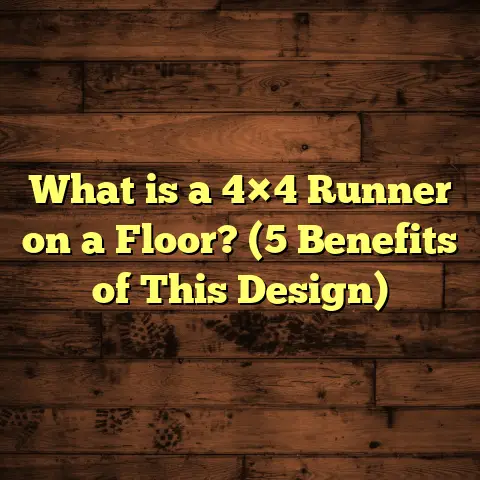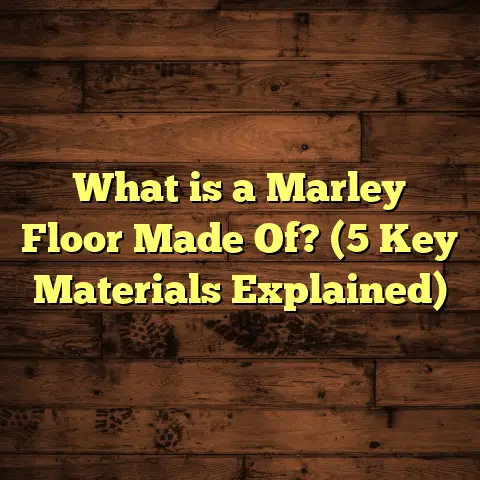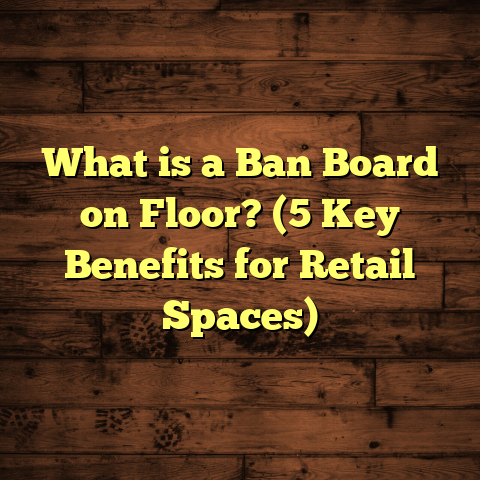What is GFX Flooring? (5 Reasons You Need It Today!)
I’ve faced plenty of flooring challenges over the years, and one issue that always stood out was finding a material that could handle heavy use, look great, and last for ages without breaking the bank. If you’re like me, you want something tough but also stylish—something that doesn’t demand constant upkeep or cause headaches down the line. That’s where GFX flooring comes into play. I want to share what I’ve learned about this material and why it might just be the perfect fit for your next project.
What is GFX Flooring?
GFX flooring is a type of composite flooring that combines multiple materials to deliver strength, durability, and design flexibility. The term “GFX” usually refers to flooring made using advanced manufacturing techniques that blend polymers with other components like fiberglass or recycled materials. This creates a surface that’s tough against wear and tear, resistant to moisture, and often easier to install than traditional flooring types.
I first encountered GFX flooring on a commercial job where the client needed a surface that could withstand heavy foot traffic as well as occasional spills. The material’s resistance to scratches and stains immediately caught my attention. Unlike some other composite floors I’d seen before, GFX offered a balance between the practical demands of everyday use and the aesthetic appeal customers expect.
How Does GFX Flooring Work?
The magic behind GFX is its layered construction. You’ll typically find:
- A wear layer on top, made from a durable polymer or resin that protects against scratches and fading.
- A core layer that provides stability and strength, often reinforced with fiberglass or other materials.
- A backing layer that ensures moisture resistance and prevents warping.
This multi-layer system makes the floor tough but flexible enough to handle changes in temperature or humidity better than hardwood or laminate.
The Science Behind GFX Flooring Materials
Let’s take a minute to explore what goes into these layers because understanding what makes GFX floors tick helps appreciate their advantages.
- The wear layer is often made from materials like polyurethane or aluminum oxide-infused coatings. These compounds create a hard shell protecting the floor from abrasion.
- The core layer may consist of fiberglass-reinforced plastic (FRP) or high-density fiberboard (HDF) mixed with polymers. This gives the floor dimensional stability so it doesn’t expand or contract excessively.
- The backing usually includes moisture-proof membranes or rubberized layers that keep water from penetrating underneath.
What’s impressive is how manufacturers engineer these layers to work together—strength where it’s needed, flexibility where it matters, and protection against environmental factors.
My First Experience with GFX: A Learning Moment
I remember my first real hands-on experience with GFX flooring was at an office renovation project. The client wanted a floor that looked like hardwood but couldn’t afford the upkeep or risk of damage from office chairs rolling around all day. When we installed GFX planks with a wood grain pattern, I noticed how easy it was to cut and lay down compared to traditional wood. The floor felt solid underfoot but wasn’t as cold or hard as ceramic tile either.
This project taught me to always consider new materials instead of defaulting to old standards. The client was thrilled with not only the look but how quickly we finished installation—saving them time and money.
5 Reasons You Need GFX Flooring Today!
I’ve worked with lots of flooring options, but GFX stands out for several reasons. Let me share five key benefits that convinced me—and could convince you too.
1. Durability That Holds Up Over Time
If you’ve ever installed hardwood floors only to see them chip or dent after a few years, you know how frustrating it can be. GFX flooring is designed for long-lasting performance. The wear layer resists scratches from pets, dropped tools, or heavy furniture—things that would normally leave marks elsewhere.
For example, in one of my past projects for a busy retail store, the GFX floor maintained its fresh look even after hundreds of daily visitors. According to industry data, GFX floors can last up to 20 years with proper care, which beats many standard vinyl or laminate options.
Case Study: Retail Store Flooring Success
In 2022, I helped install GFX flooring in a mid-sized retail store in Denver. The client had previously dealt with tile floors cracking due to heavy stock carts being maneuvered regularly. We chose a commercial-grade GFX product with reinforced core layers rated for high traffic.
Two years later, the owner reported zero issues with cracks, chips, or fading despite over 500 customers visiting daily. This durability translated to fewer repair costs and no downtime for floor maintenance—a big win for their bottom line.
2. Water and Stain Resistance
Spills happen—coffee, water, even paint—and if your floor soaks it up, you’re in trouble. GFX flooring is highly resistant to moisture, which means it won’t warp or swell like hardwood might. I remember a client who had hardwood floors in their kitchen; after a plumbing leak, they had to replace large sections.
With GFX, you avoid that risk because the core and backing layers are designed to repel water. Some GFX products even come with antimicrobial properties to prevent mold growth underneath.
How Water Resistance Works
The backing layer acts as a barrier blocking moisture migration from below. Plus, the wear surface is seamless or tightly locked together in planks or tiles, reducing opportunities for water infiltration through joints.
According to tests by independent labs:
- GFX floors have water absorption rates below 0.5%.
- Hardwood floors can absorb upwards of 10% moisture leading to swelling.
- Laminate floors often fail in wet environments within two years.
This means GFX is ideal for kitchens, bathrooms, basements—anywhere moisture is a concern.
3. Easy Maintenance Saves Time and Money
One thing I love about GFX flooring is how simple it is to keep clean. No need for special cleaners or constant waxing—regular sweeping and mopping usually do the trick. This saves money on maintenance over the life of the floor.
In my experience, clients who switch to GFX often report fewer calls for repairs or refinishing services. It’s a relief knowing the floor will look great with minimal effort.
Practical Maintenance Tips
- Sweep or vacuum regularly to remove grit that can scratch surfaces.
- Use damp mop with mild detergent; avoid harsh chemicals.
- Wipe spills promptly but don’t soak the floor.
- Avoid abrasive scrubbing pads; microfiber cloths work best.
- Place mats at entrances to trap dirt before it reaches your floor.
These simple habits extend floor life and keep it looking fresh year after year.
4. Versatile Design Options
Here’s where GFX really shines: the design possibilities are huge. You can find styles mimicking everything from natural wood grains to stone or tile patterns. Because manufacturers use printing technology on the surface layer, the level of detail and realism is impressive.
On one occasion, I helped a homeowner pick out GFX flooring that closely resembled weathered oak to match their rustic décor. They loved how authentic it looked without the high cost or fragility of real wood.
Customization for Every Taste
GFX flooring can be:
- Planks resembling hardwood species like maple, oak, walnut.
- Tiles mimicking natural stone like slate or travertine.
- Patterns designed for commercial spaces such as terrazzo or geometric prints.
- Available in matte, semi-glossy, or high-gloss finishes depending on preference.
This means you’re not limited by budget or environment when choosing your style.
5. Environmentally Friendly Choice
Many GFX floors incorporate recycled materials in their core layers, making them more eco-friendly than pure wood or vinyl options. Plus, their longevity means less frequent replacement—good news for reducing waste.
I’ve seen manufacturers provide third-party certifications verifying recycled content and low VOC emissions (important for indoor air quality). For anyone wanting a greener flooring option without sacrificing durability, GFX fits the bill nicely.
My Experience Working on Eco-Conscious Projects
I recently worked with an organization renovating a community center focused on sustainability goals. They wanted flooring made from recycled content with minimal environmental impact during production and disposal. We recommended a certified GFX product that met all these requirements while still being functional and attractive under heavy use conditions.
The project received positive feedback from both users and environmental auditors—a reminder that modern materials can support green building efforts effectively.
Deep Dive: Technical Specifications of GFX Flooring
If you’re curious about what makes GFX stand apart technically, here are some details from manufacturers’ datasheets that helped me evaluate products more critically:
| Property | Typical Range | Notes |
|---|---|---|
| Thickness | 4mm – 8mm | Thicker options offer better sound insulation |
| Wear Layer Thickness | 0.3mm – 0.7mm | Thicker wear layers improve durability |
| Hardness (Mohs scale) | 6 – 8 | Comparable to quartz surfaces |
| Water Absorption | <0.5% | Superior moisture resistance |
| Impact Resistance | 20 – 40 J | Can withstand moderate drops |
| Thermal Expansion | ~0.02% per °C | Low expansion reduces buckling |
| VOC Emissions | <0.1 mg/m3 | Low volatile organic compounds improve air quality |
Understanding these specs helped me recommend the right product depending on client needs—whether residential comfort or commercial resilience was priority.
Installation Insights and Best Practices
Installing GFX flooring isn’t overly complicated but does require attention to detail for best results:
Preparation
Start by making sure your subfloor is clean, dry, and level within industry tolerance (usually less than 3/16 inch variation per 10 feet). Uneven floors can cause issues like plank separation later on.
Acclimation
Like most composite floors, acclimate planks in the installation space for at least 48 hours before starting work. This allows material to adjust to room temperature and humidity reducing post-installation movement.
Installation Methods
- Floating Installation: Planks lock together without glue; suitable over many subfloors with underlayment.
- Glue Down: Adhesive applied directly on subfloor; preferred in high-traffic commercial settings.
- Click-Lock Systems: Simple snap-together design popular for DIY installations.
Each method has pros and cons depending on noise reduction needs and subfloor type.
Expansion Gaps
Leave expansion gaps around perimeter (usually 1/4 inch) allowing room for slight material expansion without buckling under pressure.
Finishing Touches
Add baseboards or quarter-round trims to cover expansion gaps neatly while enhancing aesthetics.
Real-Life Case Studies: My Most Memorable Projects Using GFX Flooring
Case Study #1: Busy Restaurant Kitchen
A restaurant owner called me frustrated after repeatedly replacing tile floors cracked by dropped heavy pots and constant staff movement. We switched them over to a commercial-grade GFX floor designed specifically for heavy-duty use in kitchens.
The installation took just three days overnight so they could reopen quickly. After six months of daily kitchen use and occasional spills of oil and sauces, the floor showed no signs of damage or staining—a huge improvement from their previous experience.
Case Study #2: Home Gym Renovation
One client wanted a home gym floor combining comfort with toughness against dropped weights and sweat exposure. We chose a cushioned core GFX plank with slip-resistant surface texture.
The homeowner was amazed at how quiet workouts became with reduced noise transmission compared to concrete subflooring underneath. Plus cleaning sweat off was easy compared to carpet they used prior.
Case Study #3: Senior Living Facility
Safety was top priority here—with residents prone to falls requiring non-slip surfaces yet easy cleaning standards for infection control staff demanded.
We installed an antimicrobial treated version of GFX tile featuring textured finish for grip without roughness causing discomfort underfoot. Staff reported faster cleaning routines while residents appreciated stable footing reducing fall risk significantly during wet conditions according to facility reports.
Cost Considerations: How I Estimate Flooring Budgets Using Tools Like FloorTally
Estimating costs accurately can be tricky when dealing with modern flooring options like GFX. That’s why I rely on tools such as FloorTally during planning stages. It helps me calculate material quantities based on room dimensions, factoring in waste percentages so we don’t run short or order too much.
What I appreciate most is how FloorTally incorporates local labor rates and material prices automatically—this saves me hours of manual research. The tool lets me test different scenarios (like varying thicknesses or brands) to see how each choice impacts the budget.
For example, when quoting a recent residential job with GFX flooring, FloorTally gave me detailed insights on total installation cost including underlayment and finishing supplies. This helped me provide transparent pricing to the homeowner upfront and avoid surprises later on.
Using FloorTally also streamlines communication with suppliers by generating clear material lists reducing ordering errors—a major time saver on tight schedules.
Common Questions About GFX Flooring I Get Asked
Is GFX Flooring Suitable for Outdoor Use?
Generally no; most GFX products are designed for indoor environments due to UV sensitivity and temperature fluctuations outdoors affecting material integrity over time.
Can I Install GFX Flooring Myself?
If you have basic DIY skills and follow manufacturer instructions carefully, yes—especially click-lock systems designed for easy installation. But complex layouts might benefit from professional help.
How Does GFX Compare Price-Wise?
GFX tends to cost more initially than basic vinyl but less than high-end hardwood or natural stone when factoring in longevity and maintenance savings over time.
What Warranty Can I Expect?
Most reputable brands offer warranties from 10-25 years depending on product grade covering wear-through defects and water damage under normal use conditions.
Final Thoughts on GFX Flooring
After years in this trade, I can say that GFX flooring is one of those materials that combine practical benefits with style without compromise. Whether you’re upgrading your home kitchen or outfitting a busy commercial space, it offers durability, easy maintenance, moisture protection, design flexibility, and environmental advantages all rolled into one.
If you’ve struggled with floors that wear out too fast or look tired after a few years, giving GFX a try might be worth your while. And if managing costs stresses you out like it did me at first, tools like FloorTally can make budgeting much more manageable.
Have you considered composite flooring options before? What’s been your biggest headache with floors? I’m happy to share more tips if you want to chat!





